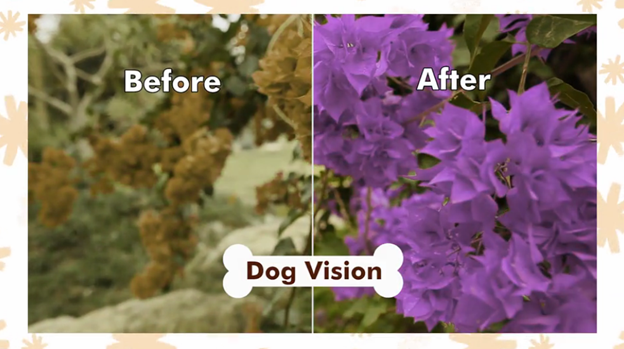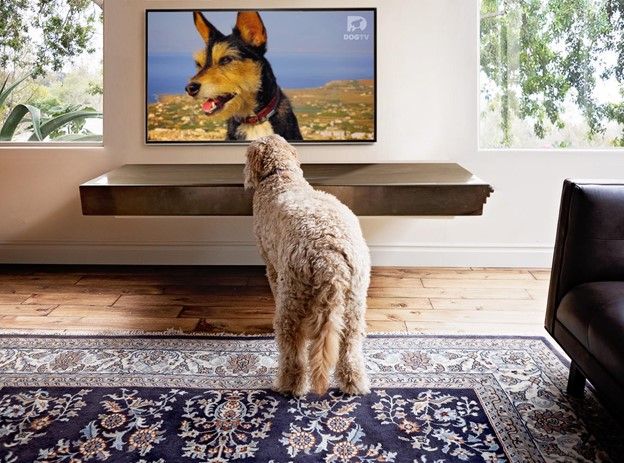The bond between humans and our pets is unbreakable, and we have no doubt that you know your dog inside and out. You can pick their favorite toy out of a lineup, and you read their facial expressions and body language like a pro.
But we bet there are still a couple of things you don’t know about Fido! The next time your dog gives you those puppy-dog eyes (which will surely be any minute now) consider these not-so well known facts about your dog’s eyes and vision:

Cones and Rods
You may remember from your high school biology class, our eyes contain light receptors called cones and rods. Cones detect different colors, and rods are responsible for detecting light levels and motion. Dogs’ eyes also have cones and rods. But their eyes have fewer cones, which means they don’t see as many colors as humans do. On the flip side, however, their eyes have more rods, which allow them to see better in dim lighting.
Dogs’ eyes also have an extra layer of eye tissue that we don’t. It’s called the tapetum lucidum, and it sits at the back of the eye and acts as a mirror, reflecting light into the retina. This tissue also aids their vision in low light - and it’s the reason their eyes give off that eerie green glow you can sometimes see at night.
Visual Acuity
Visual acuity describes how clear or sharp your vision is. You’re probably familiar with the expression “20/20 vision” - but do you know what it means? Simply put, perfect 20/20 vision means that you have normal sharpness of vision to see detail from 20 feet away. 20/40 vision means you’d need to be 20 feet away to see what someone with normal vision would see from 40 feet away. It would mean you’d fail a standard driver’s license vision test!
Most dogs are closer to 20/75 vision - which means that they would need to be 20 feet away from an object, in order to see it as well as a human with normal vision would see it from 75 feet. This means that anything below the third line of an eye chart is going to be a blur for your dog. There are exceptions though. Certain breeds are known to have better visual acuity. For example, Labradors are bred for better vision, and theirs is closer to 20/20.
Dichromatic Vision
You’ve probably heard at some point that dogs are colorblind. It’s a popular myth that dogs see only in black and white, but not quite accurate. Due to the lower number of cones in their eyes, dogs don’t see the full range of colors that humans do - but they can still detect color! Dogs have what is called dichromatic vision, which means they see in two color variations. Those colors are mainly blue and yellow. Dogs can also see shades of gray and brown. This is similar to what humans with red-green color blindness see.

So what does this actually mean for your dog? Are you curious what life looks like through your pup's eyes? You can get an approximation using the Dog VISION Image Processing Tool online. You can upload a selfie to see what you look like to your dog, or a photo of a rainbow to see how your pup views Roy G Biv.
Dogs’ Eyes Are Sensitive to Movement
With all those extra rods, dogs’ eyes are able to detect motion much better than human eyes. And with their eyes set more toward the sides of their heads, as compared to human eyes that face front and center, dogs also have a better range of peripheral vision, so they are able to notice movements in the distance that humans aren’t able to perceive.
Dogs Prefer Certain Images
Various research studies have shown that there are definitely images and scenes that dogs show more interest in. Most pups will show more interest in the TV when other animals are shown on screen - other dogs in particular.

Did You Know There’s a TV Channel Made Just For Dogs?
The pack over at DOGTV has spent years poring over scientific research studies learning how to create TV. The colors are adjusted to ensure dogs can see and enjoy what is on screen, and the soundtrack is created just for dogs too. You can try out the subscription service and get your first month free, and watch your dog’s eyes light up (possibly literally, if the tapetum lucidum is doing its job!) while you stream TV created just for them.
It may feel disheartening at first when you learn that your dog doesn’t see life with the same rich detail as you and I do - but don’t worry too much about your pup. They are getting all the information they need visually, and their keen senses of smell and hearing also help to inform them of what is happening in their environment. They are able to take in a symphony of sounds and smells that our human senses can’t perceive.
Now when you gaze lovingly into your dog’s eyes, you can do so with a deeper and more empathetic understanding of how they experience the world around them.

